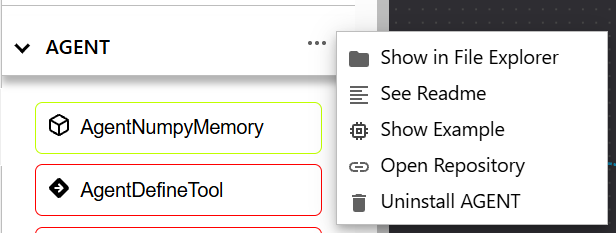We’re excited to share Xircuits 1.19 with you. This release focuses on improving canvas interactions and workflow management based on the feedback we’ve received from the community.
Streamlined Canvas Interactions
One of the most requested features is now here: “Drop Node on Link” functionality. You can drag a component from the library and drop it directly onto any connection line in your workflow. Xircuits automatically inserts the new node between the existing connections, saving you the steps of manually disconnecting and reconnecting nodes.
Link connections are now more flexible - you can drop main flow connections anywhere on the node body rather than having to precisely hit the port.
Enhanced Navigation and Discovery
Finding your way around complex workflows is now easier with two new features:
In-Canvas Search lets you quickly locate specific components within your workflow. Press Ctrl+F to search for any node, and Xircuits will help you navigate directly to it. All the components found will be highlighted in gold, while the current focus as selected blue. Especially useful for those larger projects where you need to find something specific.
Zoom to Fit automatically adjusts your canvas view to show your entire workflow at once. Whether you’re working on a large data pipeline or want to get an overview of your project, this feature shows you the complete picture with a single click.
Parallel Processing for CPU-Intensive Tasks
The new RunParallelProcess component addresses a key limitation of Python’s threading model. While Xircuits already included a RunParallelThread component, Python’s Global Interpreter Lock (GIL) prevents threads from achieving true parallelism for CPU-bound tasks like mathematical computations.
It uses separate processes instead of threads, enabling genuine parallel execution for CPU-intensive workloads. This is particularly beneficial for heavy computational tasks like scientific simulations where every performance gain matters.
Important note: Components executed in parallel processes will log their output to the terminal where JupyterLab was launched, rather than appearing in the JupyterLab output panel.
Smarter Error Prevention and Feedback
We’ve improved how Xircuits communicates potential issues. The notification system now alerts you when compulsory ports are left unconnected, helping you catch errors before running your workflows. These warnings appear both in the interface and command-line.
We’ve also replaced our old tooltip system by integrating with the Jupyterlab error notifications and added a “Show Node” button to help you quickly find the source of error.
Better Component Library Management
Managing your component libraries is now more straightforward with uninstall support available in both the UI and CLI.

Cross-Platform Improvements
Mac users will appreciate our enhanced support for the ⌘ (Command) key in keyboard shortcuts, making the experience feel more native on macOS. We’ve also fixed several compatibility issues, including better support for JupyterLab 4.4 and improved rendering performance on slower systems.
Additional Improvements
This release and additional patch followups includes numerous behind-the-scenes enhancements:
- Improved zoom controls with better visual consistency
- Fixed workflow rendering issues on slower CPUs
- Enhanced test coverage with new Playwright tests
- Security updates and dependency improvements
Looking Ahead
For our upcoming release, expect significant changes including how we display tooltips, a revamp of the component library management system, and updates to project templates. We’re working on these improvements to make Xircuits even more user-friendly and powerful.
Getting Started
Update your existing Xircuits installation or grab the latest version from our GitHub repository. We’re excited to see how these new canvas interaction features work in your projects.
